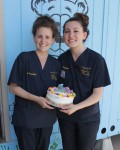Hours before the sun rose and Los Angeles traffic congested roadways, a group of UCLA student volunteers drove 150 miles to run a medical clinic in a small community on the outskirts of Tijuana, Mexico.
Flying Samaritans at UCLA is a nonprofit student group that provides the local community members free access to basic health care. The group also aims to educate local residents about preventative care and taking their health into their own hands, said Lyolya Hovhannisyan, a fourth-year neuroscience student and co-president of the student group.
Flying Samaritans at UCLA celebrated its one-year anniversary on Saturday by hosting a party, complete with a piñata and a birthday cake, at the Colonia Margarita Moran clinic in Mexico.
The UCLA chapter is part of the larger Flying Samaritans international organization, whose members are commonly known as “Flying Sams.” There are more than 200 active members in the UCLA chapter and the group organizes trips to Colonia Margarita Moran on the third Saturday of every month.
Hovhannisyan said its first clinic did not have partitioners and clients had to shuffle from table to table. Since then, the group revamped the interior of the facility and organized a community-wide beautification project to paint the outside of the clinic.
Flying Samaritans members have learned through their health assessments of the patients over the past year that a large number of residents do not have access to a safe, outside area for physical exercise, said Becky Barber, a fourth-year neuroscience student and co-president of Flying Samaritans at UCLA.
A number of donations, grants and fundraisers organized by club members throughout the year provide funding for the group, Hovhannisyan said.
On Saturday, local residents shuffled in when the clinic doors opened in the late morning for routine vitals checks, like blood pressure and vision assessments.
Gabriel Vahí-Ferguson, a San Diego State University alumnus and one of the founders of his school’s Flying Samaritans chapter, managed one of the tables where patients were referred to for a vitals checkup.
“When I first started doing this clinic, every patient I saw told me they had only eaten a cup of rice and a cup of beans for that whole day,” Vahí-Ferguson said. “So I did this for a month to get a new perspective and really understand my patients’ health concerns.”
When a health concern is detected during a vitals check, the patient is referred to one of the doctors floating around the clinic. The group brings in three to five doctors each visit to oversee the medical needs students are not qualified to treat.
Lynn Mann, a pediatrician, traveled all the way from Vermont at the request of her daughter, Barber, to help give the residential children medical examinations.
Mann, 56, said she encouraged staff at the hospital she works at, Southwestern Vermont Medical Center, to donate medical supplies, such as sanitary gloves and strep test kits, for the clinic. She also organized for Reach Out and Read, a nonprofit organization of medical providers, to donate children’s books to the clinic.
After the clinic opened on Saturday, a group of students headed into the community to speak with a local Catholic priest about improving the infrastructure of the clinic, said Matt Arguello, the external vice president of Flying Samaritans at UCLA.
Arguello, a fourth-year molecular, cell, and developmental biology student, said the priest found a few local residents to help build a bathroom facility with flushing toilets and a sink with running water at the clinic because the current facilities do not include their own bathroom.
Members pay an annual membership fee and a separate fee when they attend the clinic to cover gas costs and a one-day Mexican car insurance fee.
Most of the prescription drugs and over-the-counter medication are ordered through Dr. Shantu Patel, who works with the group and Kingsway Charities, an organization that dispenses medications and medical supplies received from pharmaceutical donors worldwide, Hovhannisyan said.
Pamela Meza, the newly elected student clinic coordinator, paced around the room and worked with different patients and students. The second-year psychobiology student was drawn to the group because she thought there was room to grow in the group and the founding members were open to hearing outside ideas.
“Over the Christmas clinic we had a lot of people donate gifts for the children,” Meza said. “(Flying Sams) wrapped up the gifts and when we brought them to the children the expressions of gratitude were unforgettable. I knew then I was really in this club for the long haul.”
The current officers said they have large-scale goals for the Flying Samaritans at UCLA in the future.
Barber said she wants to see the group create a health resource catalog that informs community members about the locations of nearby health clinics so local residents know where to get health care when Flying Sams are not present.
The group wants to create a community recreation area for a two-prong purpose – to create a mental health support group and to train community leaders in health services for when Flying Samaritans at UCLA is not present, Hovhannisyan said.
About a full workday after the students headed out to the clinic, they hoisted up a star-shaped piñata, using the water drain as leverage. On top of the roof, two students held the rope connected to the orange, red and blue star, while the children at the clinic cheerfully swung at the piñata.
After each child had an opportunity to swing, the piñata burst and the children clamored for the chocolate candy bars and Laffy Taffy that fell to the ground.
